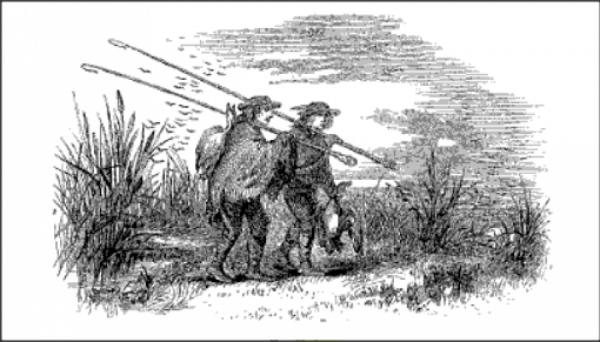Lincolnshire’s Last Hunter-Gatherers by Jim Snee
It is commonly asserted that society evolved from hunter gathering to farming and then to the industrial. Like many common assertions this is an oversimplification. One of the great complexities that archaeologists must understand is those instances where different societies exist side by side, or even one within the other. Lincolnshire, being a remarkable source of archaeological and historical data provides two such examples; the survival of a hunter gatherer society in the fens and the woodland industries of the medieval and post-medieval periods.
Of these, the survival of the fen hunter gathers is the most significant because we have historical evidence of continuity that is missing in other cases.
For the majority of Lincolnshire, hunter gathering was replaced as the main means of feeding the population in the Neolithic period. That is not to say that this was not supplemented by hunting and fishing, but the bulk of the diet came from farmed crops (in particular arable crops such as wheat) and domesticated animals such as cattle and sheep or goats (it is archaeologically impossible to tell the difference between a sheep and a goat).
By the Roman period the bulk of Lincolnshire had a robust agricultural economy that was able to produce enough surplus food that the society could support people who didn’t produce food, but did other things like working metal and making pots.
But Lincolnshire is a county with a variety of landscapes and the fens, for much of history, has not been conducive to farming. That people lived there is attested by the number of prehistoric and Roman-British sites that have been discovered and although most of the archaeological work has centred on salt-making sites, there are many indicates of general, if diffuse, settlement of the region.
In the Anglo-Saxon period we have our first written accounts of the people of the fens and these are significant in that they tell us about their language and their appearance. The Venerable Bede, writing in about AD731 describes the fens as part of the province of the Girvii tribe and notes that they had their own princes. This tribal name probably translates as “Marsh People” but has a British construction similar to the tribal name Corieltauvi that applied to the peoples of Lincolnshire when the Romans arrived. More significantly we have the life of St Guthlac (written about the same time) which describes the “demons” of the fens as speaking in a Brythonic (ancient British) language. There is also a description of their fearsome appearance in terms of yellow skin and twisted limbs, which are similar to later, more reasoned, accounts of fen ague and malaria, which were prevalent among fen dwellers.
The archaeology of the fens for this period is also noteworthy as we have evidence from Boston and elsewhere of seasonal settlement, which is normally an indication of a mobile hunter gatherer society.
From the Vikings we have a small but significant piece of evidence in the form of a place name. Scrane End, a hamlet on the wash known better as North Sea Camp, is possibly derived from the Old Norse name for natives – Skraeling. This is the word that the Vikings used to describe the Inuit and Native Americans.
In the 16th century there are references to the fen inhabitants being “Scotchmen” which would suggest that their language was still essentially Brythonic rather than English. In 1689 the people are described as “a half savage population known by the name of Bleedlings,” that led “an amphibious life, – sometimes wading, and sometimes rowing, from one islet of firm ground to another.” The name is no longer that of an ancient British tribe, but it remains archaic retaining the Anglos-Saxon tribal suffix “Inga”
It was in the 17th century that the great undertaking of draining the fens was begun, much to the anger of the local populous who petitioned against drainage on the grounds that it would rob them of the livelihood they made from grazing, fish, hunting fowl and cutting reeds. When petitions failed, they resorted to violence in the form of rioting and the rather unique game of fen football (but that is a story for another day). With civil war breaking out between King and Parliament, the drainage works were almost completely destroyed or abandoned, and the Bleedlings were able to continue their unique lifestyle.
Time, however, was running out. In the 18th century the countries drive towards Industrial modernity had little concern for small tribal people. The drainage engineers returned to the fens, this time supported by the militaristic might of the Georgian dynasty.
The fen hunter gathers, Slodgers as they were now known (probably disparagingly – meaning ‘muddy people’) were forced to the fringes of society, in the last remnants of wet fen. Although they continued to live by fishing and hunting for at least several generations. By the time Pishey Thompson wrote his “History and Antiquities of Boston and the Hundred of Skirbeck” the fen Slodgers were just a memory. The last hunter gatherers in Lincolnshire were gone.
Gone, but not forgotten.
